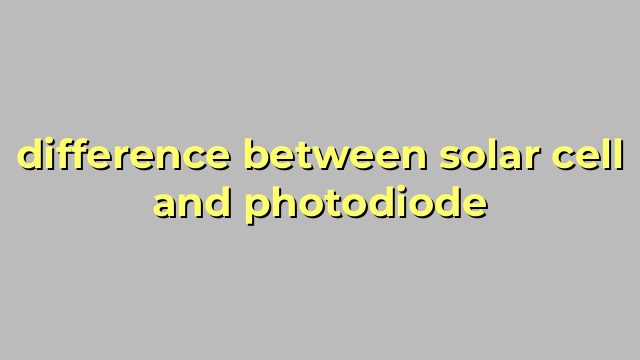The Difference Between Solar Cell and Photodiode
When it comes to solar energy and light sensing applications, two devices that are commonly used are the solar cell and photodiode. While both devices can convert light energy into electrical energy, they are quite different from each other in terms of operating principles, structures, and uses.
Solar Cell
A solar cell, also known as a photovoltaic (PV) cell, is a device that can convert sunlight into electricity by the photovoltaic effect. It consists of a semiconductor material, usually silicon, that is doped with impurities to create a p-n junction. When light falls on the cell, it excites electrons in the semiconductor, and some of them are released from the bound state and become free to move, creating a flow of electrons or current.
Solar cells are widely used in solar panels, which can provide electricity to homes, businesses, and vehicles. They are also used in calculators, watches, and other small electronic devices that require low power. Solar cells are known for their high efficiency, durability, and low maintenance. They can generate electricity even in low-light conditions, such as on cloudy days or in shaded areas.
Photodiode
A photodiode is a type of semiconductor device that can convert light into current or voltage by the photoelectric effect. It has a p-n or p-i-n structure, similar to a solar cell, and is usually operated in reverse bias mode to increase its sensitivity. When light falls on the diode, it generates electron-hole pairs, which are swept out by the electric field, creating a current proportional to the intensity of the light.
Photodiodes are commonly used in light sensing applications, such as optical communication, industrial automation, and medical instruments. They are known for their fast response, high sensitivity, and low noise. They can detect a wide range of wavelengths, from ultraviolet to near-infrared, and are capable of detecting single photons in some cases.
The Bottom Line
In summary, a solar cell and photodiode are both devices that can convert light energy into electrical energy, but they have different structures, operating principles, and applications. Solar cells are used for generating electricity from sunlight, while photodiodes are used for detecting or measuring light in various fields. Understanding the differences between these two devices can help to choose the right one for your specific needs.
Table difference between solar cell and photodiode
| Feature | Solar Cell | Photodiode |
|---|---|---|
| Function | Converts light energy into electrical energy | Converts light energy into a change in electrical resistance or current |
| Construction | Made of materials such as silicon or cadmium telluride | Made of materials such as gallium arsenide or silicon |
| Operational Mode | Operates in the photo-voltaic mode, where light energy hitting the cell knocks electrons loose to generate a current | Operates in the photoconductive mode, where light energy causes the resistance of the device to change |
| Applications | Used to provide power to homes, businesses, and other applications such as vehicles, remote areas, etc. | Used in light sensing applications such as fiber optic communication, photometry, spectroscopy, and ambient light detection |
| Efficiency | Can have high efficiencies, with some types exceeding 40% | Typically less efficient than solar cells, with most types having efficiencies below 30% |

